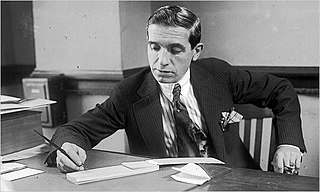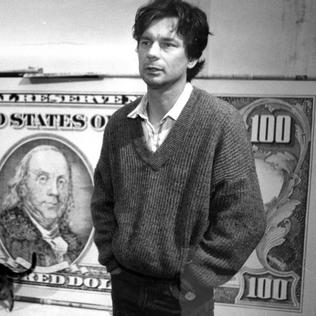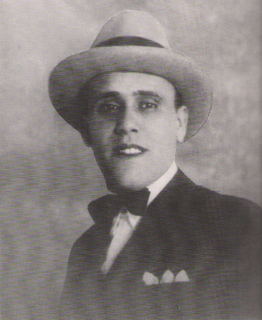
A Ponzi scheme is a form of fraud that lures investors and pays profits to earlier investors with funds from more recent investors. The scheme leads victims to believe that profits are coming from legitimate business activity, and they remain unaware that other investors are the source of funds. A Ponzi scheme can maintain the illusion of a sustainable business as long as new investors contribute new funds, and as long as most of the investors do not demand full repayment and still believe in the non-existent assets they are purported to own.

Operation Bernhard was an exercise by Nazi Germany to forge British bank notes. The initial plan was to drop the notes over Britain to bring about a collapse of the British economy during the Second World War. The first phase was run from early 1940 by the Sicherheitsdienst (SD) under the title Unternehmen Andreas. The unit successfully duplicated the rag paper used by the British, produced near-identical engraving blocks and deduced the algorithm used to create the alpha-numeric serial code on each note. The unit closed in early 1942 after its head, Alfred Naujocks, fell out of favour with his superior officer, Reinhard Heydrich.
Bank fraud is the use of potentially illegal means to obtain money, assets, or other property owned or held by a financial institution, or to obtain money from depositors by fraudulently posing as a bank or other financial institution. In many instances, bank fraud is a criminal offence. While the specific elements of particular banking fraud laws vary depending on jurisdictions, the term bank fraud applies to actions that employ a scheme or artifice, as opposed to bank robbery or theft. For this reason, bank fraud is sometimes considered a white-collar crime.

James Stephen George Boggs was an American artist, best known for his hand-drawn depictions of banknotes.

A superdollar is a very high quality counterfeit United States one hundred-dollar bill, alleged by the U.S. Government to have been made by unknown organizations or governments. In 2011, government sources stated that these counterfeit bills were in "worldwide circulation" from the late 1980s until at least July 2000 in an extradition court case.

Artur Virgílio Alves Reis was a Portuguese criminal who perpetrated one of the largest frauds in history, against the Bank of Portugal in 1925, often called the Portuguese Bank Note Crisis.

Counterfeit money is currency produced without the legal sanction of the State or government, usually in a deliberate attempt to imitate that currency and so as to deceive its recipient. Producing or using counterfeit money is a form of fraud or forgery, and is illegal. The business of counterfeiting money is almost as old as money itself: plated copies have been found of Lydian coins, which are thought to be among the first Western coins. Before the introduction of paper money, the most prevalent method of counterfeiting involved mixing base metals with pure gold or silver. Another form of counterfeiting is the production of documents by legitimate printers in response to fraudulent instructions. During World War II, the Nazis forged British pounds and American dollars. Today some of the finest counterfeit banknotes are called Superdollars because of their high quality and imitation of the real US dollar. There has been significant counterfeiting of Euro banknotes and coins since the launch of the currency in 2002, but considerably less than that of the US dollar.

Counterfeiting of the currency of the United States is widely attempted. According to the United States Department of Treasury, an estimated $70 million in counterfeit bills are in circulation, or approximately 1 note in counterfeits for every 10,000 in genuine currency, with an upper bound of $200 million counterfeit, or 1 counterfeit per 4,000 genuine notes. However, these numbers are based on annual seizure rates on counterfeiting, and the actual stock of counterfeit money is uncertain because some counterfeit notes successfully circulate for a few transactions.
David Hale is a former Arkansas municipal judge and former Arkansas banker. He alleged the charges that resulted in the Whitewater scandal trials.

Money is any item or verifiable record that is generally accepted as payment for goods and services and repayment of debts, such as taxes, in a particular country or socio-economic context. The main functions of money are distinguished as: a medium of exchange, a unit of account, a store of value and sometimes, a standard of deferred payment. Any item or verifiable record that fulfils these functions can be considered as money.
This page is a glossary of notaphily. Notaphily is the study of paper money or banknotes.
The redemption movement is a debt-resistance movement and fraud scheme active primarily in the United States and Canada. Participants allege that a secret fund is created for every citizen at birth, and that a procedure exists to "redeem" or reclaim this fund to pay bills. Common redemption schemes include acceptance for value (A4V), Treasury Direct Accounts (TDA) and secured party creditor kits.
David Kenneth Drumm is an Irish chartered accountant, former banker and convicted criminal, best known for the crimes he committed as head of Anglo Irish Bank from 2005 to December 2008, when he resigned, amid mounting revelations over hidden loans. The scandal precipitated a collapse of the bank's share price, which in turn led to its nationalisation on 21 January 2009.
The Summit County Historical Society of Akron, Ohio, abbreviated SCHS, is a 501(c)(3) non-profit organization located in Akron, Ohio. It focuses on the history of the City of Akron and Summit County, Ohio.
Jerome Schneider is an American financial adviser and author who encouraged his clients to hide their money from taxes using offshore banks. From the mid-1970s to the late 1990s, he advertised widely and, in his books and seminars, encouraged clients to buy offshore banks for their own purposes. In 2004 Schneider was convicted of conspiring to help clients evade tax laws, leading the New York Times to name him "the nation's best-known seller of fraudulent offshore banks".

Lottery fraud is any act committed to defraud a lottery game. A perpetrator attempts to win a jackpot prize through fraudulent means. The aim is to defraud the organisation running the lottery of money, or in the case of a stolen lottery ticket, to defraud an individual of their legitimately won prize.
Brian Kim is an American former hedge fund manager. He founded the now-defunct Liquid Capital Management LLC, which focused on futures trading.

The Franc affair was a plot by Hungarian nationalists to forge French bank notes. In the aftermath of World War I, Hungary lost a large part of its territory and population in a series of treaties its people considered unjust. This led many Hungarians to turn towards nationalism and revanchism. In 1922, Prince Lajos Windischgraetz was approached by Gyula Mészáros who presented him with a plan to counterfeit the French franc. Windischgraetz sought to damage the French economy while simultaneously raising funds for an internal coup in Hungary and irredentist activities. The plan came to halt when the notes produced by Mészáros were judged to be too primitive. In the summer of 1923, Windischgraetz met with German nationalist and retired Prussian Army General Erich Ludendorff who prompted him to utilize the forging equipment left from a similar unrealized German conspiracy.











